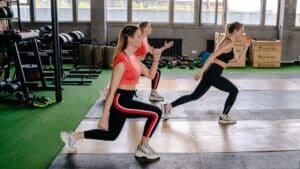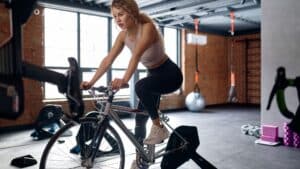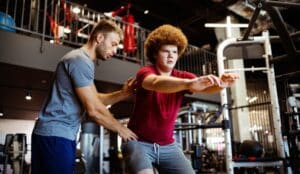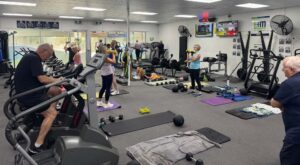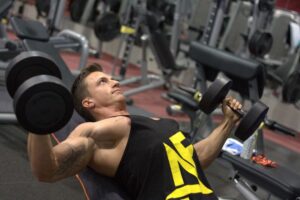A strong and toned back is a crucial foundation for overall health and fitness, especially for women. Beyond aesthetics, a well-developed back supports good posture, reduces the risk of back pain, and enhances functional movements in our daily lives. Whether you’re an athlete, a fitness enthusiast, or simply seeking to improve your well-being, incorporating the best back exercises into your workout routine can make a significant difference.
The back is a complex muscle group comprising various muscles that work together to support and stabilize the spine. As women, it is essential to target these muscles effectively, ensuring balance and strength throughout the back. In this article, we will explore a curated selection of the most effective back exercises tailored specifically for women. From targeting the latissimus dorsi muscles to engaging the rhomboids and trapezius, we will guide you through a range of exercises that will help you strengthen, tone, and transform your back.
Whether you’re a beginner or an experienced fitness enthusiast, these exercises can be adapted to suit your fitness level. Before you embark on your journey to a stronger back, remember that consistency, proper form, and progressive overload are key to achieving your goals safely and effectively. So, let’s dive in and discover the best back exercises for women that will elevate your fitness journey and empower you to conquer new heights of strength and well-being.
Why Focus on Back Exercises?
Focusing on back exercises is of paramount importance for maintaining a healthy, strong, and functional body. The back is a complex network of muscles, tendons, and ligaments that play a crucial role in supporting the spine, facilitating movement, and providing stability throughout the body. By prioritizing back exercises in your fitness routine, you can reap numerous benefits that contribute to your overall well-being and quality of life.
Posture and Alignment: A strong back is the cornerstone of good posture. Strengthening the muscles that surround the spine, such as the erector spinae, helps to maintain proper alignment, reducing the risk of developing postural issues such as kyphosis or lordosis.
Back Pain Relief and Prevention: Back pain is a prevalent concern for people of all ages, and it can be debilitating. Engaging in regular back exercises can help alleviate existing back pain and prevent future occurrences by promoting muscle balance, flexibility, and improved spinal support.
Functional Fitness and Daily Activities: From lifting groceries to bending over to tie your shoes, our daily activities heavily rely on a strong and stable back. By strengthening the back muscles, you enhance your ability to perform everyday tasks with ease and efficiency.
Injury Prevention: Weak back muscles can make you more susceptible to injuries during physical activities or even while performing routine movements. By building strength in the back, you create a solid foundation that minimizes the risk of strains, sprains, and other injuries.
Enhanced Athletic Performance: Whether you’re an athlete or a fitness enthusiast, a strong back is essential for optimal athletic performance. A robust back enhances power, stability, and technique in various sports and exercises.
Core Strength and Stability: The back muscles are integral components of the core, which acts as the body’s central support system. Strengthening the back complements abdominal exercises, leading to improved core strength and stability.
Balanced Physique: An aesthetically pleasing physique goes beyond just focusing on the front muscles. A well-developed back creates symmetry, contributing to a balanced and proportional physique.
Improved Spinal Health and Flexibility: A flexible and resilient back supports spinal health by reducing the strain on intervertebral discs and promoting proper spinal alignment. This can be especially beneficial as we age, helping to mitigate age-related back issues.
Boosted Confidence and Mental Well-Being: Achieving progress in back exercises can boost your confidence and self-esteem. Physical activity, including back exercises, releases endorphins, leading to improved mood and reduced stress.
Holistic Fitness Approach: A well-rounded fitness regimen includes targeting all major muscle groups, and the back is no exception. Incorporating back exercises ensures a comprehensive approach to fitness and overall body conditioning.
Whether you’re a seasoned athlete or a beginner on your fitness journey, incorporating back exercises into your routine can lead to lasting benefits for your body and mind. Always remember to perform exercises with proper form and consider consulting a fitness professional if you have specific health concerns or goals. A strong and resilient back is an investment in your well-being and longevity, paving the way for a healthier and more active lifestyle.
Before diving into the exercises, it’s crucial to understand the importance of working on your back muscles. The back is a vital part of your core and provides stability to your spine. Strengthening your back muscles can alleviate back pain, correct poor posture, and enhance your overall athletic performance. Now, let’s explore the top back exercises that can bring about these benefits.
1. Bent-Over Rows
Bent-over rows are a fundamental strength training exercise that targets the muscles of the upper back, including the latissimus dorsi (lats), rhomboids, and trapezius, as well as the biceps and rear deltoids. This compound movement is highly effective for building a strong and well-defined back, enhancing overall upper body strength, and improving posture.
Execution:
To perform bent-over rows, follow these step-by-step instructions:
Starting Position: Stand with your feet shoulder-width apart, holding a dumbbell in each hand or gripping a barbell with an overhand grip. Hinge at the hips, keeping your back flat and chest up, until your upper body is nearly parallel to the ground. Allow your arms to hang straight down, and maintain a slight bend in your knees for stability.
Pulling Movement: Initiate the movement by pulling the dumbbells or barbell up towards your chest, leading with your elbows. Keep your arms close to your body throughout the motion. Focus on squeezing your shoulder blades together as you lift the weight, engaging the muscles of your upper back.
Contraction: At the top of the movement, your elbows should be pointing towards the ceiling, and the dumbbells or barbell should be close to your body, just below your chest.
Lowering Phase: Slowly lower the weights back down to the starting position in a controlled manner, maintaining tension in your back muscles.
Breathing: Exhale as you pull the weight up and inhale as you lower it back down.
Modifications:
Bent-over rows can be modified based on fitness level and equipment availability:
– If you’re new to the exercise, consider starting with lighter weights or using resistance bands to focus on form and control.
– For variety, you can perform bent-over rows with a wider grip on the barbell or use an underhand grip, which emphasizes different muscle groups.
– If you prefer bodyweight exercises or have limited equipment, you can do bodyweight rows using a suspension trainer or a sturdy horizontal bar.
Benefits:
Incorporating bent-over rows into your workout routine offers a host of benefits:
Back Strength: Bent-over rows are one of the most effective exercises for building a strong and well-developed back.
Posture Improvement: Strengthening the back muscles helps to improve posture and reduce the risk of developing rounded shoulders or slouching.
Upper Body Development: This exercise engages the biceps and rear deltoids, contributing to overall upper body strength and definition.
Core Stabilization: As a compound movement, bent-over rows require core engagement for stability and balance.
Functional Fitness: The strength gained from bent-over rows translates to improved performance in everyday activities and sports.
Injury Prevention: Strengthening the back muscles can help prevent back pain and injuries by providing better support to the spine.
To ensure proper form and maximize the benefits of bent-over rows, focus on maintaining a flat back throughout the movement and avoid using excessive momentum or swinging. If you have any existing back issues or concerns, consider consulting with a fitness professional or personal trainer for guidance. With consistent practice, bent-over rows can become a staple exercise in your routine, contributing to a stronger, more toned back and an overall empowered and capable physique.
2. Lat Pulldowns
Lat pulldowns are a popular and effective strength training exercise that primarily targets the latissimus dorsi muscles, commonly referred to as the “lats.” This compound movement also engages other muscles in the upper body, including the biceps, rear deltoids, and rhomboids, making it a valuable addition to any workout routine.
Execution:
To perform lat pulldowns, follow these step-by-step instructions:
Starting Position: Sit on a lat pulldown machine, securing your thighs under the thigh pads. Grasp the wide bar with an overhand grip, hands placed slightly wider than shoulder-width apart. Your arms should be fully extended overhead.
Pulling Movement: Initiate the exercise by pulling the bar down towards your chest in a controlled manner. Focus on engaging your back muscles and squeezing your shoulder blades together as you pull the bar down.
Contraction: At the bottom of the movement, the bar should be at chest level, and your elbows should be pointing down. Pause for a brief moment to feel the contraction in your lats.
Returning to Starting Position: Slowly release the bar back up to the starting position, extending your arms fully.
Breathing: Exhale as you pull the bar down and inhale as you return to the starting position.
Modifications:
Lat pulldowns can be adapted to suit different fitness levels and equipment availability:
– If you’re a beginner, start with a weight that allows you to perform the exercise with proper form and gradually increase the resistance as you become more comfortable.
– For variation, you can use different grip attachments, such as a narrow grip or an underhand grip, to target the lats and biceps from different angles.
– If you don’t have access to a lat pulldown machine, resistance bands or cable machines can be used as alternatives.
Benefits:
Incorporating lat pulldowns into your workout routine provides numerous benefits:
Lat Development: Lat pulldowns are one of the most effective exercises for targeting and developing the lats, contributing to a wider and more defined back.
Upper Body Strength: This exercise engages various upper body muscles, including the biceps, rear deltoids, and rhomboids, leading to improved overall upper body strength.
Posture Improvement: Strengthening the lats and back muscles helps maintain good posture and reduces the risk of developing rounded shoulders.
Functional Fitness: Strong lats are crucial for various functional movements, such as pulling, lifting, and carrying objects.
Versatility: Lat pulldowns can be performed in different ways, allowing for varied grips and positions to target specific muscle groups.
Support for Pull-Up Progression: Mastering lat pulldowns can serve as a stepping stone to progress towards full pull-ups, especially for beginners.
As with any exercise, proper form is essential to maximize benefits and prevent injuries. Avoid using momentum or swinging to perform the movement and maintain a stable seated position throughout the exercise. If you’re unsure about your form or have any existing back or shoulder issues, consider consulting with a fitness professional or personal trainer for guidance. By consistently incorporating lat pulldowns into your routine, you can achieve a stronger, more sculpted back and upper body, empowering you to tackle daily activities and fitness goals with confidence.
3. Renegade Rows
Renegade rows are a challenging and highly effective strength training exercise that targets multiple muscle groups, including the back, core, and shoulders. This compound movement combines elements of a plank and a rowing exercise, making it a dynamic and functional addition to any workout routine.
Execution:
To perform renegade rows, follow these step-by-step instructions:
Starting Position: Begin in a plank position with your hands directly under your shoulders and your feet hip-width apart. Place a dumbbell in each hand, maintaining a strong and stable plank position.
Rowing Movement: While keeping your core engaged and hips stable, lift one dumbbell off the ground by pulling your elbow back towards the ceiling. Focus on squeezing your shoulder blade as you perform the rowing motion.
Contraction: At the top of the movement, the dumbbell should be near your ribcage, and your elbow should be pointing towards the ceiling. Hold for a brief moment to feel the contraction in your back muscles.
Lowering Phase: Slowly lower the dumbbell back to the ground in a controlled manner. Maintain stability in your plank position throughout the movement.
Alternating Sides: After completing one repetition on one side, switch to the other side and perform the row with the opposite arm.
Breathing: Exhale as you pull the dumbbell up and inhale as you lower it back down.
Modifications:
Renegade rows can be modified based on fitness level and equipment availability:
– If you’re new to the exercise, consider starting with lighter dumbbells or using no weights at all to focus on mastering the plank and rowing movement.
– If you don’t have dumbbells, you can perform renegade rows using kettlebells, water bottles, or other objects with enough weight for resistance.
Benefits:
Incorporating renegade rows into your workout routine offers a host of benefits:
Back and Core Strength: Renegade rows effectively target the back muscles, particularly the latissimus dorsi, rhomboids, and trapezius, while also engaging the core for stability.
Improved Stability and Balance: This exercise challenges your stability and balance, requiring proper alignment and control to perform the rowing movement.
Functional Fitness: Renegade rows simulate real-life movements, making them highly functional for activities that involve pulling or lifting.
Upper Body Definition: Regularly performing renegade rows can lead to a more sculpted and defined upper body, especially the back and shoulders.
Time Efficiency: Renegade rows provide a full-body workout in a single exercise, making them a time-efficient addition to your training routine.
Versatility: Renegade rows can be performed with various weights and equipment, allowing for progression and adaptation based on individual fitness levels.
As with any exercise, proper form is essential to maximize benefits and prevent injuries. Focus on maintaining a stable plank position and avoid rotating or swaying your hips during the rowing movement. If you have any existing shoulder or core issues, consider consulting with a fitness professional or personal trainer for guidance. By incorporating renegade rows into your routine, you can strengthen your back, core, and shoulders, enhancing your overall functional fitness and empowering you to take on new challenges with confidence.
4. Reverse Flyes
Reverse flyes, also known as rear delt flyes or posterior deltoid raises, are a valuable strength training exercise that targets the muscles of the upper back and shoulders. This isolation movement is specifically designed to engage the rear deltoid muscles, which are located at the back of the shoulders, as well as the rhomboids and trapezius.
Execution:
To perform reverse flyes, follow these step-by-step instructions:
Starting Position: Stand with your feet shoulder-width apart and hold a dumbbell in each hand. Hinge forward at the hips, keeping your back flat and chest up. Allow your arms to hang straight down from your shoulders, palms facing each other. Your arms should form a slight angle with your body.
Fly Movement: Initiate the exercise by lifting both arms out to the sides, forming a “T” shape with your body. Focus on squeezing your shoulder blades together as you raise the dumbbells.
Contraction: At the top of the movement, your arms should be parallel to the ground, and your shoulders should be externally rotated, with your thumbs pointing up. Hold for a brief moment to feel the contraction in your rear deltoids.
Lowering Phase: Slowly lower the dumbbells back to the starting position in a controlled manner, maintaining tension in your rear deltoids and back muscles.
Breathing: Exhale as you lift the dumbbells and inhale as you lower them back down.
Modifications:
Reverse flyes can be modified based on fitness level and equipment availability:
– If you’re new to the exercise or have limited shoulder mobility, start with lighter dumbbells or resistance bands to focus on proper form and control.
– If you don’t have dumbbells, you can use resistance bands or perform reverse flyes on a cable machine with appropriate attachments.
Benefits:
Incorporating reverse flyes into your workout routine provides several benefits:
Rear Deltoid Development: Reverse flyes effectively target the rear deltoid muscles, helping to develop strong and defined shoulders.
Improved Posture: Strengthening the rear deltoids and upper back muscles can help improve posture and reduce the risk of rounded shoulders.
Balanced Shoulder Muscles: Reverse flyes help balance the shoulder muscles by targeting the often neglected rear deltoids, which are crucial for overall shoulder stability.
Functional Fitness: This exercise simulates movements involved in pulling and reaching, making it valuable for everyday activities and sports performance.
Injury Prevention: Strengthening the rear deltoids and upper back can contribute to preventing shoulder injuries by providing better support and stability to the shoulder joint.
Versatility: Reverse flyes can be performed using various equipment, making them adaptable to different fitness levels and workout environments.
As with any exercise, proper form is crucial to maximize benefits and prevent injuries. Keep your back flat and avoid using momentum or swinging to perform the movement. If you have any existing shoulder issues or concerns, consider consulting with a fitness professional or personal trainer for guidance. By consistently incorporating reverse flyes into your routine, you can develop stronger rear deltoids and upper back muscles, leading to improved shoulder stability, better posture, and enhanced overall upper body strength.
5. Bird-Dog Exercise
The bird-dog exercise, also known as the quadruped or all-fours exercise, is a popular core stabilization and balance exercise that targets the muscles of the core, lower back, and glutes. It is a simple yet effective bodyweight exercise that can be performed by individuals of all fitness levels, making it a valuable addition to any workout routine or rehabilitation program.
Execution:
To perform the bird-dog exercise, follow these step-by-step instructions:
Starting Position: Begin on your hands and knees, with your hands directly under your shoulders and your knees directly under your hips. Maintain a neutral spine with your back flat and core engaged.
Extension Movement: Simultaneously extend your right arm straight forward and your left leg straight backward, keeping them parallel to the ground. Your arm and leg should be in line with your body, and your hips should remain level throughout the movement.
Hold and Contract: Pause briefly at the top of the extension to engage your core and glutes, maintaining balance and stability.
Returning to Starting Position: Slowly bring your right arm and left leg back to the starting position, placing your hand and knee back on the ground.
Alternating Sides: After completing one repetition on one side, switch to the other side and extend your left arm and right leg.
Breathing: Exhale as you extend your arm and leg and inhale as you return to the starting position.
**Modifications:**
The bird-dog exercise can be modified based on individual fitness levels and needs:
– If you’re new to the exercise or have balance issues, you can start by extending just the arm or leg individually before progressing to the full movement.
– If you have wrist discomfort, you can perform the bird-dog exercise on your forearms instead of your hands.
Benefits:
Incorporating the bird-dog exercise into your workout routine offers several benefits:
Core Stability: The bird-dog exercise engages the core muscles, including the transverse abdominis and obliques, to stabilize the spine during the movement.
Lower Back Strengthening: By extending the opposite arm and leg, the exercise targets the erector spinae muscles of the lower back, promoting back strength and stability.
Balance and Coordination: The exercise challenges your balance and coordination, enhancing proprioception and motor control.
Postural Support: Strengthening the core and lower back muscles can contribute to improved posture and reduced risk of lower back pain.
Functional Fitness: The bird-dog exercise mimics movements involved in activities such as walking, running, and reaching, making it relevant for everyday functional fitness.
Injury Rehabilitation: The bird-dog exercise is often recommended by physical therapists and healthcare professionals for rehabilitating lower back and core injuries.
As with any exercise, maintaining proper form is crucial to maximize benefits and prevent injuries. Focus on keeping your back flat and avoid arching or rounding your spine during the movement. If you have any existing back or shoulder issues, consider consulting with a fitness professional or physical therapist for personalized guidance. By consistently incorporating the bird-dog exercise into your routine, you can develop a strong and stable core, improve balance and coordination, and support a healthy and functional spine.
Conclusion
The best back exercises for women are essential for overall health, fitness, and well-being. From posture improvement and back pain prevention to functional fitness and balanced muscle development, these exercises offer a comprehensive approach to achieving a strong and resilient back. By incorporating these exercises into their workout routines, women can take significant steps toward realizing their fitness goals and living a healthier and more active lifestyle. Always remember to listen to your body, consult with fitness professionals when needed, and celebrate the progress made on your fitness journey. With dedication and commitment, women can strengthen and tone their back muscles, unlocking their full potential for a happier and healthier life.

